- +91 9871190713
- drgyansclinic@gmail.com
- Shop No. 9, 1st Floor, Kshitij Complex, Sector 4, Vaishali, GZB

Alopecia areata, also known as spot baldness, is a condition in which hair is lost from some or all areas of the body. Often it results in a few bald spots on the scalp, each about the size of a coin. Psychological stress may result. People are generally otherwise healthy. In a few, all the hair on the scalp or all body hair is lost and loss can be permanent. Alopecia areata is believed to be an autoimmune disease.Risk factors include a family history of the condition. Among identical twins if one is affected the other has about a 50% chance of also being affected. The underlying mechanism involves failure by the body to recognize its own cells with subsequent immune mediated destruction of the hair follicle.

Acanthosis nigricans is a brown to black, poorly defined, velvety hyperpigmentation of the skin. It is usually found in body folds, such as the posterior and lateral folds of the neck, the armpits, groin, navel, forehead, and other areas. Acanthosis nigricans is conventionally divided into benign and malignant forms, although may be divided into syndromes according to cause: Benign This may include obesity-related, hereditary, and endocrine forms of acanthosis nigricans. Malignant. This may include forms that are associated with tumour products and insulin-like activity, or tumour necrosis factor.

Boils are usually small areas (penny or nickel size) with a thin covering of skin, while abscesses are larger raised areas on the skin that are tender to touch and filled with pus in the deeper tissue. Abscesses and boils may drain when the skin over the infected area opens and lets the fluid or pus out. Signs of cellulitis include areas of redness, skin tenderness, and fever. All of these skin infections are usually warmer than the surrounding normal areas of skin because of the body’s reaction to the infection. Person-to-person contact with pus and skin bacteria and to a lesser extent, contaminated environmental surfaces and objects.
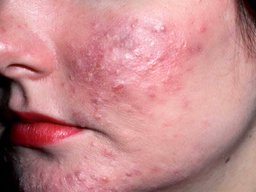
Rosacea is a long-term skin condition that typically affects the face. It results in redness, pimples, swelling, and small and superficial dilated blood vessels. Often the nose, cheeks, forehead, and chin are most involved. A red enlarged nose may occur in severe disease, a condition known as rhinophyma. The cause of rosacea is unknown. Risk factors are believed to include a family history of the condition. Factors that may potentially worsen the condition include heat, exercise, sunlight, cold, spicy food, alcohol, menopause, psychological stress, or steroid cream on the face. Diagnosis is based on symptoms.

Acne, also known as acne vulgaris, is a long-term skin disease that occurs when hair follicles are clogged with dead skin cells and oil from the skin. It is characterized by blackheads or whiteheads, pimples, oily skin, and possible scarring. It primarily affects areas of the skin with a relatively high number of oil glands, including the face, upper part of the chest, and back. The resulting appearance can lead to anxiety, reduced self-esteem and, in extreme cases, depression or thoughts of suicide. The role of diet and cigarette smoking is unclear, and neither cleanliness nor exposure to sunlight appear to play a part.

Acromegaly is a disorder that results from excess growth hormone (GH) after the growth plates have closed. The initial symptom is typically enlargement of the hands and feet. There may also be enlargement of the forehead, jaw, and nose. Other symptoms may include joint pain, thicker skin, deepening of the voice, headaches, and problems with vision. Complications of the disease may include type 2 diabetes, sleep apnea, and high blood pressure. Acromegaly is typically due to the pituitary gland producing too much growth hormone. In more than 95% of cases the excess production is due to a benign tumor, known as a pituitary adenoma.

Addison's disease, also known as primary adrenal insufficiency and hypocortisolism, is a long-term endocrine disorder in which the adrenal glands do not produce enough steroid hormones.[1] Symptoms generally come on slowly and may include abdominal pain, weakness, and weight loss. Darkening of the skin in certain areas may also occur. Under certain circumstances, an adrenal crisismay occur with low blood pressure, vomiting, lower back pain, and loss of consciousness. An adrenal crisis can be triggered by stress, such as from an injury, surgery, or infection
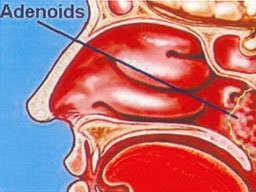
The adenoid, also known as a pharyngeal tonsil or nasopharyngeal tonsil, is the superior-most of the tonsils. It is a mass of lymphatic tissue located behind the nasal cavity, in the roof of the nasopharynx, where the nose blends into the throat. In children, it normally forms a soft mound in the roof and back wall of the nasopharynx, just above and behind the uvula. The adenoid is a mass of lymphatic tissue located behind the nasal cavity, in the roof of the nasopharynx, where the nose blends into the throat. The adenoid, unlike the palatine tonsils, has pseudostratified epithelium. The adenoids are part of the so-called Waldeyer ring of lymphoid tissue which includes the palatine tonsils and the lingual tonsils.

Attention deficit hyperactivity disorder (ADHD) is a mental disorder of the neuro developmental type.It is characterized by problems paying attention, excessive activity, or difficulty controlling behavior which is not appropriate for a person's age. The symptoms appear before a person is twelve years old, are present for more than six months, and cause problems in at least two settings (such as school, home, or recreational activities). In children, problems paying attention may result in poor school performance. Although it causes impairment, particularly in modern society, many children with ADHD have a good attention span for tasks they find interesting.

Allergies, also known as allergic diseases, are a number of conditions caused by hypersensitivity of the immune system to typically harmless substances in the environment. These diseases include hay fever, food allergies, atopic dermatitis, allergic asthma, and anaphylaxis. Symptoms may include red eyes, an itchy rash, sneezing, a runny nose, shortness of breath, or swelling. Food intolerance and food poisoning are separate conditions. Common allergens include pollen and certain food. Metals and other substances may also cause problems.

Alzheimer's disease (AD), also referred to simply as Alzheimer's, is a chronic neurodegenerative disease that usually starts slowly and worsens over time. It is the cause of 60–70% of cases of dementia. The most common early symptom is difficulty in remembering recent events (short-term memory loss). As the disease advances, symptoms can include problems with language, disorientation (including easily getting lost), mood swings, loss of motivation, not managing self care, and behavioural issues. As a person's condition declines, they often withdraw from family and society. Gradually, bodily functions are lost, ultimately leading to death.

Ankylosing spondylitis (AS) is a type of arthritis in which there is long term inflammation of the joints of the spine. Typically the joints where the spine joins the pelvis are also affected. Occasionally other joints such as the shoulders or hips are involved. Eye and bowel problems may also occur.] Back pain is a characteristic symptom of AS, and it often comes and goes. Stiffness of the affected joints generally worsens over time. Although the cause of ankylosing spondylitis is unknown, it is believed to involve a combination of genetic and environmental factors. More than 90% of those affected have a specific human leukocyte antigen known as the HLA-B27 antigen.

Anxiety disorders are a group of mental disorders characterized by significant feelings of anxiety and fear. Anxiety is a worry about future events and fear is a reaction to current events. These feelings may cause physical symptoms, such as a fast heart rate and shakiness. There are a number of anxiety disorders: including generalized anxiety disorder, specific phobia, social anxiety disorder, separation anxiety disorder, agoraphobia, panic disorder, and selective mutism. The disorder differs by what results in the symptoms. People often have more than one anxiety disorder
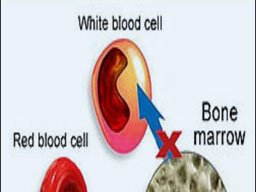
Aplastic anemia is a rare disease in which the bone marrow and the hematopoietic stem cells that reside there are damaged. This causes a deficiency of all three blood cell types (pancytopenia): red blood cells (anemia), white blood cells (leukopenia), and platelets (thrombocytopenia). Aplastic refers to inability of the stem cells to generate mature blood cells. It is more frequent in people in their teens and twenties, but is also common among the elderly. It can be caused by heredity, immune disease, or exposure to chemicals, drugs, or radiation. However, in about half the cases, the cause is unknown. The definitive diagnosis is by bone marrow biopsy; normal bone marrow has 30-70% blood stem cells, but in aplastic anemia, these cells are mostly gone and replaced by fat.

Appendicitis is inflammation of the appendix. Symptoms commonly include right lower abdominal pain, nausea, vomiting, and decreased appetite. However, approximately 40% of people do not have these typical symptoms. Severe complications of a ruptured appendix include widespread, painful inflammation of the inner lining of the abdominal wall and sepsis. Appendicitis is caused by a blockage of the hollow portion of the appendix. This is most commonly due to a calcified "stone" made of feces. Inflamed lymphoid tissue from a viral infection, parasites, gallstone, or tumors may also cause the blockage.

Chiari malformations are structural defects in the cerebellum. They consist of a downward displacement of the cerebellar tonsils through the foramen magnum (the opening at the base of the skull), sometimes causing non-communicating hydrocephalus[3] as a result of obstruction of cerebrospinal fluid (CSF) outflow. The cerebrospinal fluid outflow is caused by phase difference in outflow and influx of blood in the vasculature of the brain. The malformation is named for Austrian pathologist Hans Chiari. A type II CM is also known as an Arnold-Chiari malformation in honor of Chiari and German pathologist Julius Arnold.

Asthma is a common long-term inflammatory disease of the airways of the lungs. It is characterized by variable and recurring symptoms, reversible airflow obstruction, and bronchospasm. Symptoms include episodes of wheezing, coughing, chest tightness, and shortness of breath. These episodes may occur a few times a day or a few times per week. Depending on the person, they may become worse at night or with exercise. Asthma is thought to be caused by a combination of genetic and environmental factors. Environmental factors include exposure to air pollution and allergens.
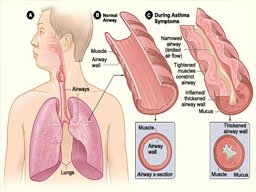
If the airways are inflamed, air has more difficulty getting to your lungs. With less air getting in, you can feel short of breath. You may wheeze and cough in an attempt to draw in more oxygen through tightened passageways. Bronchitis and asthma are two inflammatory airway conditions. Acute bronchitis is an inflammation of the lining of the airways that usually resolves itself after running its course. It's caused by viral or bacterial infections. Chronic bronchitis, which is longer lasting, can be triggered by long-term exposure to environmental irritants such as tobacco smoke, dust, or chemicals. Asthma is an inflammatory condition that leads to tightening of the muscles around the airways and swelling that cause airways to narrow. When asthma and acute bronchitis occur together, the condition is called asthmatic bronchitis.

Ataxia is a neurological sign consisting of lack of voluntary coordination of muscle movements that includes gait abnormality. Ataxia is a non-specific clinical manifestation implying dysfunction of the parts of the nervous system that coordinate movement, such as the cerebellum. Ataxia can be limited to one side of the body, which is referred to as hemiataxia. Several possible causes exist for these patterns of neurological dysfunction. Dystaxia is a mild degree of ataxia. Friedreich's ataxia has gait abnormality as the most commonly presented symptom.
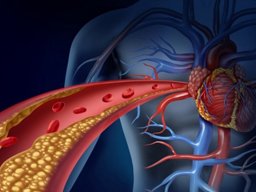
Atherosclerosis is a disease in which the inside of an artery narrows due to the build up of plaque. Initially, there are generally no symptoms. When severe, it can result in coronary artery disease, stroke, peripheral artery disease, or kidney problems depending on the arteries affected. Symptoms, if they occur, generally do not begin until middle age. The exact cause is not known. Risk factors include abnormal cholesterol levels, high blood pressure, diabetes, smoking, obesity, family history, and an unhealthy diet. Plaque is made up of fat, cholesterol, calcium, and other substances found in the blood. The narrowing of arteries limits the flow of oxygen-rich blood to parts of the body. Diagnosis is based upon a physical exam, electrocardiogram, and exercise stress test, among others. Prevention is generally by eating a healthy diet, exercising, not smoking, and maintaining a normal weight.

Autism is a developmental disorder characterized by troubles with social interaction and communication and by restricted and repetitive behavior. Parents usually notice signs in the first two or three years of their child's life. These signs often develop gradually, though some children with autism reach their developmental milestones at a normal pace and then worsen. Autism is caused by a combination of genetic and environmental factors. Risk factors include certain infections during pregnancy, such as rubella, as well as valproic acid, alcohol or cocaine use during pregnancy. Controversies surround other proposed environmental causes, for example the vaccine hypotheses, which have been disproven.

Back pain is pain felt in the back of the body. It is divided into neck pain (cervical), middle back pain (thoracic), lower back pain (lumbar) or coccydynia (tailbone or sacral pain) based on the segment affected. The lumbar area is the most common area for pain, as it supports most of the weight in the upper body. Episodes of back pain may be acute, sub-acute, or chronic depending on the duration. The pain may be characterized as a dull ache, shooting or piercing pain, or a burning sensation. Discomfort can radiate into the arms and hands as well as the legs or feet, and may include numbness, or weakness in the legs and arms.

Behcet's disease (BD) is a type of inflammatory disorder which affects multiple parts of the body. The most common symptoms include painful mouth sores, genital sores, inflammation of parts of the eye, and arthritis. The sores typically last a few days. Less commonly there may be inflammation of the brain or spinal cord, blood clots, aneurysms, or blindness. Often the symptoms come and go. The cause is unknown. It is believed to be partly genetic. Behcet's is not contagious. Diagnosis is based on at least three episodes of mouth sores in a year together with at least two of the following: genital sores, eye inflammation, skin sores, a positive skin prick test. There is no cure. Treatments may include immunosuppressive medication such as corticosteroids and lifestyle changes. Lidocaine mouthwash may help with the pain. Colchicine may decrease the frequency of attacks. The condition often improves with the passage of time.

Bell's palsy is a type of facial paralysis that results in an inability to control the facial muscles on the affected side. Symptoms can vary from mild to severe. They may include muscle twitching, weakness, or total loss of the ability to move one or rarely both sides of the face. Other symptoms include drooping of the eyelid, a change in taste, pain around the ear, and increased sensitivity to sound. Typically symptoms come on over 48 hours. The cause of Bell's palsy is unknown. Risk factors include diabetes and a recent upper respiratory tract infection. It results from a dysfunction of cranial nerve VII (the facial nerve). Many believe that this is due to a viral infection that results in swelling. Diagnosis is based on a person's appearance and ruling out other possible causes. Other conditions that can cause facial weakness include brain tumor, stroke, Ramsay Hunt syndrome, myasthenia gravis, and Lyme disease

Benign prostatic hyperplasia (BPH), also called prostate enlargement, is a noncancerous increase in size of the prostate. Symptoms may include frequent urination, trouble starting to urinate, weak stream, inability to urinate, or loss of bladder control. Complications can include urinary tract infections, bladder stones, and chronic kidney problems. The cause is unclear. Risk factors include a family history, obesity, type 2 diabetes, not enough exercise, and erectile dysfunction. Medications like pseudoephedrine, anticholinergics, and calcium channel blockers may worsen symptoms. The underlying mechanism involves the prostate pressing on the urethra thereby making it difficult to pass urine out of the bladder. Diagnosis is typically based on symptoms and examination after ruling out other possible causes.
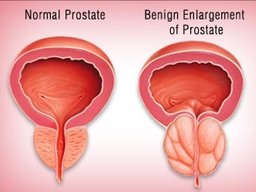
Benign prostatic hyperplasia (BPH), also called prostate enlargement, is a noncancerous increase in size of the prostate. Symptoms may include frequent urination, trouble starting to urinate, weak stream, inability to urinate, or loss of bladder control. Complications can include urinary tract infections, bladder stones, and chronic kidney problems. The cause is unclear. Risk factors include a family history, obesity, type 2 diabetes, not enough exercise, and erectile dysfunction. Medications like pseudoephedrine, anticholinergics, and calcium channel blockers may worsen symptoms. The underlying mechanism involves the prostate pressing on the urethra thereby making it difficult to pass urine out of the bladder. Diagnosis is typically based on symptoms and examination after ruling out other possible causes.

Bipolar disorder, previously known as manic depression, is a mental disorder that causes periods of depression and periods of abnormally elevated mood. The elevated mood is significant and is known as mania or hypomania, depending on its severity, or whether symptoms of psychosis are present. During mania, an individual behaves or feels abnormally energetic, happy, or irritable. Individuals often make poorly thought out decisions with little regard to the consequences. The need for sleep is usually reduced during manic phases. During periods of depression, there may be crying, a negative outlook on life, and poor eye contact with others. The risk of suicide among those with the illness is high at greater than 6 percent over 20 years, while self-harm occurs in 30-40 percent. Other mental health issues such as anxiety disorders and substance use disorder are commonly associated.

Bowen's disease is a type of skin cancer, find out more about getting diagnosed and what treatment you might expect. Bowen's disease is a very early form of squamous cell skin cancer. It's also called squamous cell carcinoma in situ. Doctors call Bowen's disease pre invasive. That means that there are cancer cells there but they are only in the outermost layer of skin, the epidermis. Sometimes it can spread along the skin surface. If left untreated, there is a small chance that Bowen's disease can spread into the deeper layers of the skin. This means it has become an invasive cancer and it can then spread into the lymphatic system. It takes a long time for Bowen's disease to develop into an invasive cancer. But the risk of developing into a cancer remains until Bowen's is treated.

Breast cancer is cancer that develops from breast tissue. Signs of breast cancer may include a lump in the breast, a change in breast shape, dimpling of the skin, fluid coming from the nipple, a newly inverted nipple, or a red or scaly patch of skin. In those with distant spread of the disease, there may be bone pain, swollen lymph nodes, shortness of breath, or yellow skin. Risk factors for developing breast cancer include being female, obesity, lack of physical exercise, drinking alcohol, hormone replacement therapy during menopause, ionizing radiation, early age at first menstruation, having children late or not at all, older age, prior history of breast cancer, and family history.
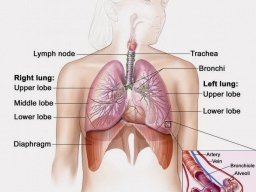
Bronchitis is inflammation of the bronchi (large and medium-sized airways) in the lungs. Symptoms include coughing up mucus, wheezing, shortness of breath, and chest discomfort. Bronchitis is divided into two types: acute and chronic. Acute bronchitis is also known as a chest cold. Acute bronchitis usually has a cough that lasts around three weeks. In more than 90% of cases the cause is a viral infection. These viruses may be spread through the air when people cough or by direct contact. Risk factors include exposure to tobacco smoke, dust, and other air pollution. A small number of cases are due to high levels of air pollution or bacteria such as Mycoplasma pneumoniae or Bordetella pertussis. Treatment of acute bronchitis typically involves rest, paracetamol (acetaminophen), and NSAIDs to help with the fever.
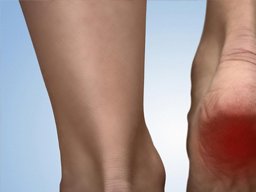
A calcaneal spur (or heel spur) is a bony outgrowth from the calcaneal tuberosity (heel bone). Calcaneal spurs are typically detected by a radiographic examination (commonly referred to as an "x-ray"). It is a form of exostosis. When a foot is exposed to constant stress, calcium deposits build up on the bottom of the heel bone. Generally, this has no effect on a person's daily life. However, repeated damage can cause these deposits to pile up on each other, causing a spur-shaped deformity, called a calcaneal (or heel) spur. An inferior calcaneal spur is located on the inferior aspect of the calcaneus and is typically a response to plantar fasciitis over a period, but may also be associated with ankylosing spondylitis (typically in children). A posterior calcaneal spur develops on the back of the heel at the insertion of the Achilles tendon.

Cancer is a group of diseases involving abnormal cell growth with the potential to invade or spread to other parts of the body. These contrast with benign tumors, which do not spread to other parts of the body. Possible signs and symptoms include a lump, abnormal bleeding, prolonged cough, unexplained weight loss and a change in bowel movements. While these symptoms may indicate cancer, they may have other causes. Over 100 types of cancers affect humans. Tobacco use is the cause of about 22% of cancer deaths. Another 10% are due to obesity, poor diet, lack of physical activity or excessive drinking of alcohol. Other factors include certain infections, exposure to ionizing radiation and environmental pollutants.

A carbuncle is a cluster of boils caused by bacterial infection, most commonly with Staphylococcus aureus or Streptococcus pyogenes. The presence of a carbuncle is a sign that the immune system is active and fighting the infection. The infection is contagious and may spread to other areas of the body, or other people; those living in the same residence may develop carbuncles at the same time. In the early 21st century, infection involving methicillin-resistant staphylococcus aureus (MRSA) has become more common. A carbuncle is a cluster of several boils, which is typically filled with purulent exudate (dead neutrophils, phagocitized bacteria, and other cellular components). Fluid may drain freely from the carbuncle, or intervention involving an incision and drainage procedure may be needed.

Oral thrush occurs when a yeast infection develops on the inside of your mouth and on your tongue. This condition is also known as oral candidiasis, oropharyngeal candidiasis, or, simply, thrush. The Candida albicans (C. albicans) fungus causes oral thrush. A small amount of this fungus normally lives in your mouth without causing harm. However, when the fungus begins to grow uncontrollably, an infection can develop in your mouth. Oral thrush most often occurs in infants and toddlers. It causes white bumps to form on the inner cheeks and tongue. These growths usually go away once treatment is received. Oral thrush is typically mild and rarely causes complications. However, the condition can be problematic for those with weakened immune systems.
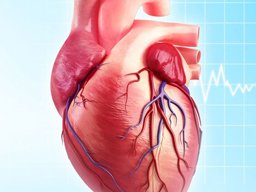
Cardiovascular disease (CVD) is a class of diseases that involve the heart or blood vessels. Cardiovascular disease includes coronary artery diseases (CAD) such as angina and myocardial infarction (commonly known as a heart attack). Other CVDs include stroke, heart failure, hypertensive heart disease, rheumatic heart disease, cardiomyopathy, heart arrhythmia, congenital heart disease, valvular heart disease, carditis, aortic aneurysms, peripheral artery disease, thromboembolic disease, and venous thrombosis. The underlying mechanisms vary depending on the disease. Coronary artery disease, stroke, and peripheral artery disease involve atherosclerosis.

Carpal tunnel syndrome (CTS) is a medical condition due to compression of the median nerve as it travels through the wrist at the carpal tunnel. The main symptoms are pain, numbness, and tingling, in the thumb, index finger, middle finger, and the thumb side of the ring fingers. Symptoms typically start gradually and during the night. Pain may extend up the arm. Weak grip strength may occur and after a long period of time the muscles at the base of the thumb may waste away. In more than half of cases both sides are affected. Risk factors include obesity, repetitive wrist work, pregnancy, and rheumatoid arthritis.
A cataract is a clouding of the lens in the eye which leads to a decrease in vision. Cataracts often develop slowly and can affect one or both eyes. Symptoms may include faded colors, blurry vision, halos around light, trouble with bright lights, and trouble seeing at night. This may result in trouble driving, reading, or recognizing faces. Poor vision caused by cataracts may also result in an increased risk of falling and depression.[2] Cataracts cause half of all cases of blindness and 33% of visual impairment worldwide.

Cellulitis is a bacterial infection involving the inner layers of the skin. It specifically affects the dermis and subcutaneous fat. Signs and symptoms include an area of redness which increases in size over a few days. The borders of the area of redness are generally not sharp and the skin may be swollen. While the redness often turns white when pressure is applied, this is not always the case. The area of infection is usually painful. Lymphatic vessels may occasionally be involved, and the person may have a fever and feel tired.
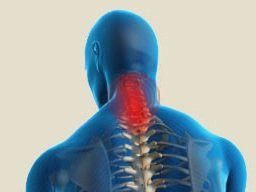
Cervical spondylosis is a common, age-related condition that affects the joints and discs in your cervical spine, which is in your neck. It’s also known as cervical osteoarthritis or neck arthritis. It develops from wear and tear of cartilage and bones. While it’s largely due to age, it can be caused by other factors as well. According to the Dr. Gyan Clinic, the condition is present in more than 85 percent of people over the age of 60, although some people who have it never experience symptoms.
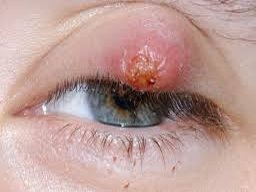
Chalazion is a cyst in the eyelid due to a blocked oil gland. They are typically in the middle of the eyelid, red, and non painful. They tend to come on gradually over a few weeks. A chalazion may occur following a stye or from hardened oils blocking the gland. The blocked gland is usually the meibomian gland but can also be the gland of Zeis. A stye and cellulitis may appear similar. A stye, however, is usually more sudden in onset, painful, and occurs at the edge of the eyelid. Cellulitis is also typically painful. Treatment is typically initially with warm compresses. If this is not effective injecting steroids into the lesion may be tried. If large, incision and drainage may be recommended. While relatively common the frequency of the condition is unknown.

Chikungunya is an infection caused by the chikungunya virus (CHIKV). Symptoms include fever and joint pain. These typically occur two to twelve days after exposure. Other symptoms may include headache, muscle pain, joint swelling, and a rash. Most people are better within a week; however, occasionally the joint pain may last for months. The risk of death is around 1 in 1,000. The very young, old, and those with other health problems are at risk of more severe disease. The virus is spread between people by two types of mosquitos: Aedes albopictus and Aedes aegypti.

Asthma is the leading cause of chronic illness in children. It affects about 7 million children in the United States and, for unknown reasons, is steadily increasing. Asthma can begin at any age (even in the very elderly), but most children have their first symptoms by age 5.No one really knows the exact reasons why more and more children are developing asthma. Some experts suggest that children spend too much time indoors and are exposed to more and more dust, air pollution, and secondhand smoke. Some suspect that children are not exposed to enough childhood illnesses to direct the attention of their immune system to bacteria and viruses.

Chronic fatigue syndrome (CFS), also referred to as myalgic encephalomyelitis (ME), is a medical condition characterized by long-term fatigue and other symptoms that limit a person's ability to carry out ordinary daily activities. Biological, genetic, infectious, and psychological mechanisms have been proposed, but the cause is not understood. Diagnosis is based on a person's symptoms. The fatigue is not due to strenuous ongoing exertion, is not much relieved by rest, and is not due to a previous medical condition. Fatigue is a common symptom in many illnesses, but the unexplained fatigue and severity of functional impairment in CFS is comparatively rare.
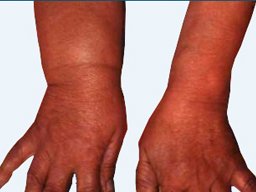
Chyluria, also called chylous urine, is a medical condition involving the presence of chyle in the urine stream, which results in urine appearing milky white. The condition is usually classified as being either parasitic or non parasitic. It is a condition that is more prevalent among people of Africa and the Indian subcontinent. Chyluria appearance is irregular and intermittent. It may last several days, weeks or even months. There are several factors that trigger Chyluria recurrence. Chyluria is often caused by filariasis due to the parasite Wuchereria bancrofti, a thready nematode which lodges the lymph channels. The parasitic infection can lead to obstruction of peripheral lymphatic vessels and increased pressure within the vessels causing collateral flow of the lymph.
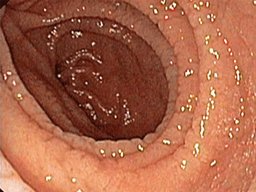
Coeliac disease, also spelled celiac disease, is a long-term autoimmune disorder that primarily affects the small intestine. Classic symptoms include gastrointestinal problems such as chronic diarrhoea, abdominal distention, malabsorption, loss of appetite and among children failure to grow normally. This often begins between six months and two years of age. Non-classic symptoms are more common, especially in people older than two years. There may be mild or absent gastrointestinal symptoms, a wide number of symptoms involving any part of the body or no obvious symptoms. Coeliac disease was first described in childhood; however, it may develop at any age. It is associated with other autoimmune diseases, such as diabetes mellitus type 1 and thyroiditis, among others.
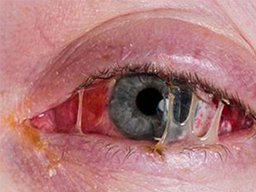
Conjunctivitis, also known as pink eye, is inflammation of the outermost layer of the white part of the eye and the inner surface of the eyelid. It makes the eye appear pink or reddish. There may also be pain, burning, scratchiness, or itchiness. The affected eye may have increased tears or be "stuck shut" in the morning. Swelling of the white part of the eye, may also occur. Itching is more common in cases due to allergies. Conjunctivitis can affect one or both eyes. The most common infectious causes are viral followed by bacterial. The viral infection may occur along with other symptoms of a common cold. Both viral and bacterial cases are easily spread between people.

Constipation refers to bowel movements that are infrequent or hard to pass. The stool is often hard and dry. Other symptoms may include abdominal pain, bloating, and feeling as if one has not completely passed the bowel movement. Complications from constipation may include hemorrhoids, anal fissure or fecal impaction. The normal frequency of bowel movements in adults is between three per day and three per week. Babies often have three to four bowel movements per day while young children typically have two to three per day. Constipation has many causes. Common causes include slow movement of stool within the colon, irritable bowel syndrome, and pelvic floor disorders.

Chronic obstructive pulmonary disease (COPD) is a type of obstructive lung disease characterized by long-term breathing problems and poor airflow. The main symptoms include shortness of breath and cough with sputum production. COPD is a progressive disease, meaning it typically worsens over time. Eventually everyday activities, such as walking or getting dressed, become difficult. Chronic bronchitis and emphysema are older terms used for different types of COPD. The term "chronic bronchitis" is still used to define a productive cough that is present for at least three months each year for two years. Tobacco smoking is the most common cause of COPD, with factors such as air pollution and genetics playing a smaller role.

Corns and calluses are thick, hardened layers of skin that develop when your skin tries to protect itself against friction and pressure. They most often develop on the feet and toes or hands and fingers. Corns and calluses can be unsightly. If you're healthy, you need treatment for corns and calluses only if they cause discomfort. For most people, simply eliminating the source of friction or pressure makes corns and calluses disappear. If you have diabetes or another condition that causes poor blood flow to your feet, you're at greater risk of complications from corns and calluses. Seek your doctor's advice on proper care for corns and calluses if you have such a condition

Crohn's disease is a type of inflammatory bowel disease (IBD) that may affect any part of the gastrointestinal tract from mouth to anus. Signs and symptoms often include abdominal pain, diarrhea (which may be bloody if inflammation is severe), fever, and weight loss. Other complications may occur outside the gastrointestinal tract and include anemia, skin rashes, arthritis, inflammation of the eye, and tiredness. The skin rashes may be due to infections as well as pyoderma gangrenosum or erythema nodosum. Bowel obstruction may occur as a complication of chronic inflammation, and those with the disease are at greater risk of bowel cancer.
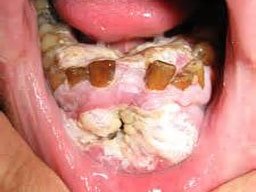
Cyclic neutropenia is a rare blood disorder characterized by recurrent episodes of abnormally low levels of neutrophils (a type of white blood cell) in the body. Neutrophils are instrumental in fighting off infection by surrounding and destroying bacteria that enter the body. Symptoms of cyclic neutropenia may include fever, a general feeling of ill health, and/or sores (ulcers) of the mucous membranes of the mouth. Individuals with low levels of neutrophils (neutropenia) are highly susceptible to recurrent infections. Cyclic neutropenia may be inherited or acquired. Some cases are present at birth and appear to occur randomly for no apparent reason (sporadic). Inherited cases appear to be transmitted in an autosomal dominant fashion and are caused by mutations in the ELANE gene.

A urinary tract infection (UTI) is an infection that affects part of the urinary tract. When it affects the lower urinary tract it is known as a bladder infection (cystitis) and when it affects the upper urinary tract it is known as kidney infection (pyelonephritis). Symptoms from a lower urinary tract include pain with urination, frequent urination, and feeling the need to urinate despite having an empty bladder. Symptoms of a kidney infection include fever and flank pain usually in addition to the symptoms of a lower UTI. Rarely the urine may appear bloody. In the very old and the very young, symptoms may be vague or non-specific. The most common cause of infection is Escherichia coli, though other bacteria or fungi may rarely be the cause. Risk factors include female anatomy, sexual intercourse, diabetes, obesity, and family history.

Dandruff is a skin condition that mainly affects the scalp. Symptoms include flaking and sometimes mild itchiness. It can result in social or self-esteem problems. A more severe form of the condition, which includes inflammation of the skin, is known as seborrheic dermatitis. The cause is unclear but believed to involve a number of genetic and environmental factors. The condition may worsen in the winter. It is not due to poor hygiene. The underlying mechanism involves the over growth of skin cells. Diagnosis is based on symptoms. There is no known cure. The typical treatment is with antifungal cream such as ketoconazole. Dandruff affects about half of adults. Onset is usually at puberty. Males are more often affected than females. Rates decrease after the age of 50.

Dengue fever is a mosquito-borne tropical disease caused by the dengue virus. Symptoms typically begin three to fourteen days after infection. This may include a high fever, headache, vomiting, muscle and joint pains, and a characteristic skin rash. Recovery generally takes two to seven days. In a small proportion of cases, the disease develops into the life-threatening dengue hemorrhagic fever, resulting in bleeding, low levels of blood platelets and blood plasma leakage, or into dengue shock syndrome, where dangerously low blood pressure occurs. Dengue is spread by several species of mosquito of the Aedes type, principally
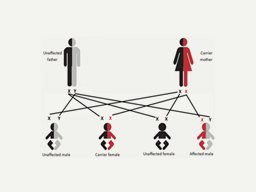
Dent's disease (or Dent disease) is a rare X-linked recessive inherited condition that affects the proximal renal tubules[1] of the kidney. It is one cause of Fanconi syndrome, and is characterized by tubular proteinuria, excess calcium in the urine, formation of calcium kidney stones, nephrocalcinosis, and chronic kidney failure. "Dent's disease" is often used to describe an entire group of familial disorders, including X-linked recessive nephrolithiasis with kidney failure, X-linked recessive hypophosphatemic rickets, and both Japanese and idiopathic low-molecular-weight proteinuria.

Depression is a state of low mood and aversion to activity that can affect a person's thoughts, behavior, tendencies, feelings, and sense of well-being. A depressed mood is a normal temporary reaction to life events such as loss of a loved one. It is also a symptom of some physical diseases and a side effect of some drugs and medical treatments. Depressed mood is also a symptom of some mood disorders such as major depressive disorder or dysthymia. Adversity in childhood, such as bereavement, neglect, mental abuse, physical abuse, sexual abuse, and unequal parental treatment of siblings can contribute to depression in adulthood. Childhood physical or sexual abuse in particular significantly correlates with the likelihood of experiencing depression over the life course.
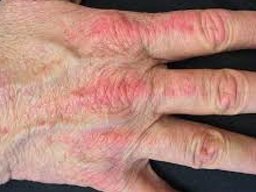
Dermatomyositis (DM) is a long term inflammatory disorder which affects muscles. Its symptoms are generally a skin rash and worsening muscle weakness over time. These may occur suddenly or develop over months. Other symptoms may include weight loss, fever, lung inflammation, or light sensitivity. Complications may include calcium deposits in muscles or skin. The cause is unknown. Theories include that it is an autoimmune disease or a result of a viral infection. It is a type of inflammatory myopathy. Diagnosis is typically based on some combination of symptoms, blood tests, electromyography, and muscle biopsies
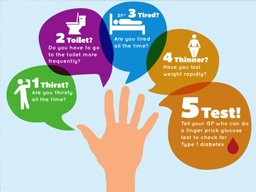
Diabetes mellitus type 1, also known as type 1 diabetes, is a form of diabetes mellitus in which not enough insulin is produced. This results in high blood sugar levels in the body. The classical symptoms are frequent urination, increased thirst, increased hunger, and weight loss. Additional symptoms may include blurry vision, feeling tired, and poor healing. Symptoms typically develop over a short period of time. The cause of type 1 diabetes is unknown. However, it is believed to involve a combination of genetic and environmental factors. Risk factors include having a family member with the condition.

Diabetes mellitus type 2 (also known as type 2 diabetes) is a long-term metabolic disorder that is characterized by high blood sugar, insulin resistance, and relative lack of insulin. Common symptoms include increased thirst, frequent urination, and unexplained weight loss. Symptoms may also include increased hunger, feeling tired, and sores that do not heal. Often symptoms come on slowly. Long-term complications from high blood sugar include heart disease, strokes, diabetic retinopathy which can result in blindness, kidney failure, and poor blood flow in the limbs which may lead to amputations. The sudden onset of hyperosmolar hyperglycemic state may occur; however, ketoacidosis is uncommon
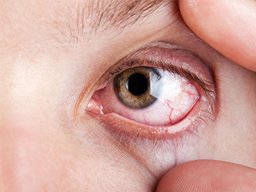
Dry eye syndrome (DES), also known as keratoconjunctivitis sicca (KCS), is the condition of having dry eyes. Other associated symptoms include irritation, redness, discharge, and easily fatigued eyes. Blurred vision may also occur. The symptoms can range from mild and occasional to severe and continuous. Scarring of the cornea may occur in some cases without treatment. Dry eye occurs when either the eye does not produce enough tears or when the tears evaporate too quickly.

Dyslexia, also known as reading disorder, is characterized by trouble with reading despite normal intelligence. Different people are affected to varying degrees. Problems may include difficulties in spelling words, reading quickly, writing words, "sounding out" words in the head, pronouncing words when reading aloud and understanding what one reads. Often these difficulties are first noticed at school. When someone who previously could read loses their ability, it is known as alexia. The difficulties are involuntary and people with this disorder have a normal desire to learn.

Dysmenorrhea, also known as painful periods, or menstrual cramps, is pain during menstruation. Its usual onset occurs around the time that menstruation begins. Symptoms typically last less than three days. The pain is usually in the pelvis or lower abdomen. Other symptoms may include back pain, diarrhea, or nausea. In young women painful periods often occur without an underlying problem. In older women it is more often due to an underlying issues such as uterine fibroids, adenomyosis, or endometriosis. It is more common among those with heavy periods, irregular periods, whose periods started before twelve years of age, or who have a low body weight.

Dermatitis, also known as eczema, is a group of diseases that results in inflammation of the skin. These diseases are characterized by itchiness, red skin and a rash. In cases of short duration, there may be small blisters, while in long-term cases the skin may become thickened. The area of skin involved can vary from small to the entire body. Dermatitis is a group of skin conditions that includes atopic dermatitis, allergic contact dermatitis, irritant contact dermatitis and stasis dermatitis. The exact cause of dermatitis is often unclear. Cases may involve a combination of irritation, allergy and poor venous return. The type of dermatitis is generally determined by the person's history and the location of the rash.

Elephantiasis is gross enlargement of a limb or any organ of the body. There is an abnormal accumulation of watery fluid in affected part,in the tissues causing severe swelling(oedema). It may affect male or female genital organs. It is caused by Nematode Wuchereria bancrofti. Elephantiasis is variety of diseases, where parts of a person's body swell to massive proportions. Elephantiasis nostras, due to longstanding chronic lymphangitisElephantiasis tropica or lymphatic filariasis, caused by a number of parasitic worms, particularly Wuchereria bancrofti. More than 120 million people, mostly in Africa and Southeast Asia, are affected.

Endometriosis is a condition in which the endometrium, the layer of tissue that normally covers the inside of the uterus, grows outside of it. Most often this is on the ovaries, fallopian tubes, and tissue around the uterus and ovaries; however, in rare cases it may also occur in other parts of the body. The main symptoms are pelvic pain and infertility. Nearly half of those affected have chronic pelvic pain, while in 70% pain occurs during menstruation. Pain during sexual intercourse is also common. Infertility occurs in up to half of women affected. Less common symptoms include urinary or bowel symptoms. About 25% of women have no symptoms. Endometriosis can have both social and psychological effects.

Epilepsy is a group of neurological disorders characterized by epileptic seizures. Epileptic seizures are episodes that can vary from brief and nearly undetectable periods to long periods of vigorous shaking. These episodes can result in physical injuries, including occasionally broken bones. In epilepsy, seizures tend to recur and, as a rule, have no immediate underlying cause. Isolated seizures that are provoked by a specific cause such as poisoning are not deemed to represent epilepsy. People with epilepsy may be treated differently in various areas of the world and experience varying degrees of social stigma due to their condition.
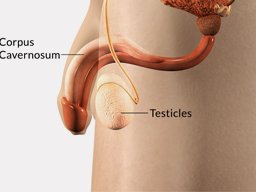
Erectile dysfunction (ED), also known as impotence, is a type of sexual dysfunction characterized by the inability to develop or maintain an erection of the penis during sexual activity. Erectile dysfunction can have psychological consequences as it can be tied to relationship difficulties and self-image. The most important organic causes of impotence are cardiovascular disease and diabetes, neurological problems (for example, trauma from prostatectomy surgery), hormonal insufficiencies (hypogonadism) and drug side effects. Psychological impotence is where erection or penetration fails due to thoughts or feelings (psychological reasons) rather than physical impossibility; this is somewhat less frequent but can often be helped. In psychological impotence, there is a strong response to placebo treatment.

Fatty liver is a reversible condition wherein large vacuoles of triglyceride fat accumulate in liver cells via the process of steatosis (i.e., abnormal retention of lipids within a cell). Despite having multiple causes, fatty liver can be considered a single disease that occurs worldwide in those with excessive alcohol intake and the obese (with or without effects of insulin resistance). The condition is also associated with other diseases that influence fat metabolism. When this process of fat metabolism is disrupted, the fat can accumulate in the liver in excessive amounts, thus resulting in a fatty liver. It is difficult to distinguish alcoholic FLD, which is part of alcoholic liver disease, from nonalcoholic FLD (NAFLD), and both show microvesicular and macrovesicular fatty changes at different stages.

Fibroadenomas, are benign breast tumours characterized by an admixture of stromal and epithelial tissue. Breasts are made of lobules (milk producing glands) and ducts (tubes that carry the milk to the nipple). These are surrounded by glandular, fibrous and fatty tissues. Fibroadenomas develop from the lobules. The glandular tissue and ducts grow over the lobule to form a solid lump. Since both fibroadenomas, and breast lumps as a sign of breast cancer can appear similar, it is recommended to perform ultrasound analyses and possibly tissue sampling with subsequent histopathologic analysis in order to make a proper diagnosis.

An anal fissure, fissure in Ano or rectal fissure is a break or tear in the skin of the anal canal. Anal fissures may be noticed by bright red anal bleeding on toilet paper and undergarments, or sometimes in the toilet. If acute they are painful after defecation, but with chronic fissures, pain intensity is often less. Anal fissures usually extend from the anal opening and are usually located posteriorly in the midline, probably because of the relatively unsupported nature and poor perfusion of the anal wall in that location. Fissure depth may be superficial or sometimes down to the underlying sphincter muscle. Untreated fissures develop a hood like skin tag (sentinel piles) which cover the fissure and cause discomfort, pain.

The respiratory system is your throat, sinuses, windpipe (trachea) and lungs. Symptoms such as runny nose, sneezing, sore throat, head congestion and cough can also be caused by allergies. ... (You call the symptoms "colds" but they are not caused by viral infections.)

The bile travels out of the gallbladder through the cystic duct, a small tube that leads to the common bile duct, and from there into the small intestine. The main cause of cholecystitis is gallstones or biliary sludge getting trapped at the gallbladder's opening. This is sometimes called a pseudolith, or "fake stone." The gallbladder is a small, pear-shaped organ connected to the liver, on the right side of the abdomen. It stores bile and releases it into the small intestine to help in the digestion of fat. The gallbladder holds bile, a fluid that is released after we eat, especially after a meal that is high in fat, and this bile aids digestion. The bile travels out of the gallbladder through the cystic duct, a small tube that leads to the common bile duct, and from there into the small intestine.
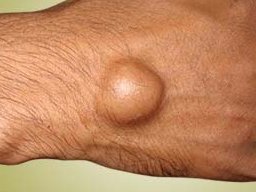
A ganglion is a nerve cell cluster or a group of nerve cell bodies located in the autonomic nervous system and sensory system. Ganglia house the cell bodies of afferent nerves (input nerve fibers) and efferent--output/motor--nerve fibers, or axons. Ganglia are primarily made up of somata and dendritic structures which are bundled or connected. Ganglia often interconnect with other ganglia to form a complex system of ganglia known as a plexus. Ganglia provide relay points and intermediary connections between different neurological structures in the body, such as the peripheral and central nervous systems.
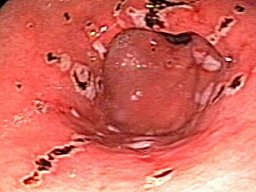
Gastritis is inflammation of the lining of the stomach. It may occur as a short episode or may be of a long duration.There may be no symptoms but, when symptoms are present, the most common is upper abdominal pain. Other possible symptoms include nausea and vomiting, bloating, loss of appetite and heartburn. Complications may include bleeding, stomach ulcers, and stomach tumors. When due to autoimmune problems, low red blood cells due to not enough vitamin B12 may occur, a condition known as pernicious anemia.

This is a chronic disease that occurs when stomach acid or bile flows into the food pipe and irritates the lining. Acid reflux and heartburn more than twice a week may indicate GERD. Symptoms include burning pain in the chest that usually occurs after eating and worsens when lying down. Relief from lifestyle changes and over-the-counter medication is usually temporary. Stronger medication may be required. Ages affected 0-2 Common, 3-5 Rare, 6-13 Rare, 14-18 Common, 19-40 Very common, 41-60 Very common 60+

Glaucoma is a group of eye diseases which result in damage to the optic nerve and vision loss. The most common type is open-angle glaucoma with less common types including closed-angle glaucoma and normal-tension glaucoma. Open-angle glaucoma develops slowly over time and there is no pain. Peripheral vision may begin to decrease followed by central vision resulting in blindness if not treated. Closed-angle glaucoma can present gradually or suddenly. The sudden presentation may involve severe eye pain, blurred vision, mid-dilated pupil, redness of the eye, and nausea. Vision loss from glaucoma, once it has occurred, is permanent.

Gout is a form of inflammatory arthritis characterized by recurrent attacks of a red, tender, hot, and swollen joint. Pain typically comes on rapidly in less than twelve hours. The joint at the base of the big toe is affected in about half of cases. It may also result in tophi, kidney stones, or urate nephropathy. Gout is due to persistently elevated levels of uric acid in the blood. This occurs due to a combination of diet and genetic factors. At high levels, uric acid crystallizes and the crystals deposit in joints, tendons, and surrounding tissues, resulting in an attack of gout. Gout occurs more commonly in those who regularly eat meat or seafood, drink beer, or are overweight.

Hair loss, also known as alopecia or baldness, refers to a loss of hair from part of the head or body. Typically at least the head is involved. The severity of hair loss can vary from a small area to the entire body. Typically inflammation or scarring is not present. Hair loss in some people causes psychological distress. Common types include: male-pattern hair loss, female-pattern hair loss, alopecia areata, and a thinning of hair known as telogen effluvium. The cause of male-pattern hair loss is a combination of genetics and male hormones, the cause of female pattern hair loss is unclear, the cause of alopecia areata is autoimmune, and the cause of telogen effluvium is typically a physically or psychologically stressful event.

Hematuria is the presence of red blood cells in the urine. Visible hematuria, also known as gross hematuria, is easily identified, as it causes red or brown discoloration of the urine. Microscopic hematuria is invisible to the naked eye and is often found incidentally on urinalysis or urine dipstick. Any part of the kidneys or urinary tract (ureters, urinary bladder, prostate, and urethra) can leak blood into the urine. The causes of hematuria are broad, ranging from urinary tract infection to kidney stones to bladder cancer.

Hemiparesis, or unilateral paresis, is weakness of one entire side of the body (hemi- means "half"). Hemiplegia is, in its most severe form, complete paralysis of half of the body. Hemiparesis and hemiplegia can be caused by different medical conditions, including congenital causes, trauma, tumors, or stroke.Depending on the type of hemiparesis diagnosed, different bodily functions can be affected. Some effects are expected (e.g., partial paralysis of a limb on the affected side). Other impairments, though, can at first seem completely non-related to the limb weakness but are, in fact, a direct result of the damage to the affected side of the brain.

Hepatitis A is an infectious disease of the liver caused by the hepatitis A virus (HAV). Many cases have few or no symptoms, especially in the young. The time between infection and symptoms, in those who develop them, is between two and six weeks. When symptoms occur, they typically last eight weeks and may include nausea, vomiting, diarrhea, jaundice, fever, and abdominal pain. Around 10-15% of people experience a recurrence of symptoms during the six months after the initial infection. Acute liver failure may rarely occur, with this being more common in the elderly.[

Hepatitis B is an infectious disease caused by the hepatitis B virus (HBV) that affects the liver. It can cause both acute and chronic infections. Many people have no symptoms during the initial infection. Some develop a rapid onset of sickness with vomiting, yellowish skin, tiredness, dark urine and abdominal pain. Often these symptoms last a few weeks and rarely does the initial infection result in death.It may take 30 to 180 days for symptoms to begin. In those who get infected around the time of birth 90% develop chronic hepatitis B while less than 10% of those infected after the age of five do. Most of those with chronic disease have no symptoms; however, cirrhosis and liver cancer may eventually develop. These complications result in the death of 15 to 25% of those with chronic disease.

Hepatitis C is an infectious disease caused by the hepatitis C virus (HCV) that primarily affects the liver. During the initial infection people often have mild or no symptoms. Occasionally a fever, dark urine, abdominal pain, and yellow tinged skin occurs. The virus persists in the liver in about 75% to 85% of those initially infected. Early on chronic infection typically has no symptoms. Over many years however, it often leads to liver disease and occasionally cirrhosis. In some cases, those with cirrhosis will develop complications such as liver failure, liver cancer, or dilated blood vessels in the esophagus and stomach. HCV is spread primarily by blood-to-blood contact associated with intravenous drug use, poorly sterilized medical equipment, needlestick injuries in healthcare, and transfusions.
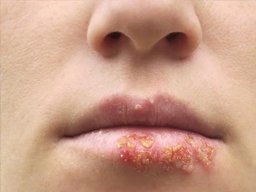
Herpes simplex is a viral disease caused by the herpes simplex virus. Infections are categorized based on the part of the body infected. Oral herpes involves the face or mouth. It may result in small blisters in groups often called cold sores or fever blisters or may just cause a sore throat. Genital herpes, often simply known as herpes, may have minimal symptoms or form blisters that break open and result in small ulcers. These typically heal over two to four weeks. Tingling or shooting pains may occur before the blisters appear. Herpes cycles between periods of active disease followed by periods without symptoms. The first episode is often more severe and may be associated with fever, muscle pains, swollen lymph nodes and headaches.

The human immunodeficiency virus (HIV) is a lentivirus (a subgroup of retrovirus) that causes HIV infection and over time acquired immunodeficiency syndrome (AIDS). AIDS is a condition in humans in which progressive failure of the immune system allows life-threatening opportunistic infections and cancers to thrive. Without treatment, average survival time after infection with HIV is estimated to be 9 to 11 years, depending on the HIV subtype. In most cases, HIV is a sexually transmitted infection and occurs by contact with or transfer of blood, pre-ejaculate, semen, and vaginal fluids. Non-sexual transmission can occur from an infected mother to her infant through breast milk. An HIV-positive mother can transmit HIV to her baby both during pregnancy and childbirth due to exposure to her blood or vaginal fluid. Within these bodily fluids.

Hyperthyroidism is the condition that occurs due to excessive production of thyroid hormone by the thyroid gland. Thyrotoxicosis is the condition that occurs due to excessive thyroid hormone of any cause and therefore includes hyperthyroidism. Some, however, use the terms interchangeably. Signs and symptoms vary between people and may include irritability, muscle weakness, sleeping problems, a fast heartbeat, heat intolerance, diarrhea, enlargement of the thyroid, and weight loss. Symptoms are typically less in the old and during pregnancy. An uncommon complication is thyroid storm in which an event such as an infection results in worsening symptoms such as confusion and a high temperature and often results in death.

Ichthyosis is a family of rare genetic skin disorders characterized by dry, thickened, scaly skin. There are more than 20 types of ichthyosis which range in severity of symptoms, outward appearance, underlying genetic cause and mode of inheritance (e.g., whether the abnormal gene inherited is dominant, recessive, autosomal or X-linked). The severity of symptoms can vary enormously, from the mildest, most common, types such as ichthyosis vulgaris, which may be mistaken for normal dry skin, up to life-threatening conditions such as harlequin-type ichthyosis. Ichthyosis vulgaris accounts for more than 95% of cases.

An ingrown nail is a common form of nail disease. It is an often painful condition in which the nail grows so that it cuts into one or both sides of the paronychium or nail bed. The common opinion is that the nail enters inside the paronychium, but an ingrown toenail can simply be overgrown toe skin. The condition starts from a microbial inflammation of the paronychium, then a granuloma, which results in a nail buried inside of the granuloma.[citation needed] While ingrown nails can occur in the nails of both the hands and the feet, they occur most commonly with the toenails. A true ingrown toenail is caused by the actual penetration of flesh by a sliver of nail.
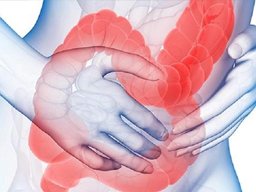
Irritable bowel syndrome (IBS) is a group of symptoms-including abdominal pain and changes in the pattern of bowel movements without any evidence of underlying damage. These symptoms occur over a long time, often years. It has been classified into four main types depending on whether diarrhea is common, constipation is common, both are common, or neither occurs very often (IBS-D, IBS-C, IBS-M, or IBS-U respectively). IBS negatively affects quality of life and may result in missed school or work. Disorders such as anxiety, major depression, and chronic fatigue syndrome are common among people with IBS.

Keloid, also known as keloid disorder and keloidal scar, is the formation of a type of scar which, depending on its maturity, is composed mainly of either type III (early) or type I (late) collagen. It is a result of an overgrowth of granulation tissue (collagen type 3) at the site of a healed skin injury which is then slowly replaced by collagen type 1. Keloids are firm, rubbery lesions or shiny, fibrous nodules, and can vary from pink to the color of the person's skin or red to dark brown in color. A keloid scar is benign and not contagious, but sometimes accompanied by severe itchiness, pain, and changes in texture. In severe cases, it can affect movement of skin. Keloid scars are seen 15 times more frequently in people of sub-Saharan African descent than in people of European descent.

Kidney stone disease, also known as urolithiasis, is when a solid piece of material (kidney stone) occurs in the urinary tract. Kidney stones typically form in the kidney and leave the body in the urine stream. A small stone may pass without causing symptoms. If a stone grows to more than 5 millimeters (0.2 in) it can cause blockage of the ureter resulting in severe pain in the lower back or abdomen. A stone may also result in blood in the urine, vomiting, or painful urination. About half of people will have another stone within ten years. Most stones form due to a combination of genetics and environmental factors.
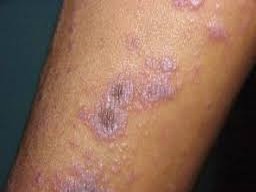
Lichen planus (LP) is a disease characterized by itchy reddish-purple polygon-shaped skin lesions on the lower back, wrists, and ankles. It may also present with a burning sensation in the mouth, and a lattice-like network of white lines near sites of erosion (Wickham striae). The cause is unknown, but it is thought to be the result of an autoimmune process with an unknown initial trigger. There is no cure, but many different medications and procedures have been used in efforts to control the symptoms. The term lichenoid reaction (or lichenoid lesion) refers to a lesion of similar or identical histopathologic and clinical appearance to lichen planus (i.e., an area which resembles lichen planus, both to the naked eye and under a microscope).

A lipoma is a benign tumor made of fat tissue. They are generally soft to the touch, movable, and painless. They usually occur just under the skin but occasionally may be deeper. Most are less than 5 cm in size. Common locations include upper back, shoulders, and abdomen. A few people have a number of lipomas. The cause is generally unclear. Risk factors include family history, obesity, and not enough exercise. Diagnosis is typically based on a physical exam. Occasionally medical imaging or tissue biopsy is used to confirm the diagnosis

Cirrhosis is a condition in which the liver does not function properly due to long-term damage.[1] This damage is characterized by the replacement of normal liver tissue by scar tissue.[1] Typically, the disease develops slowly over months or years.[1] Early on, there are often no symptoms.[1] As the disease worsens, a person may become tired, weak, itchy, have swelling in the lower legs, develop yellow skin, bruise easily, have fluid build up in the abdomen, or develop spider-like blood vessels on the skin.[1] The fluid build-up in the abdomen may become spontaneously infected.[1] Other complications include hepatic encephalopathy, bleeding from dilated veins in the esophagus or dilated stomach veins, and liver cancer.[1] Hepatic encephalopathy results in confusion and may lead to unconsciousness.

Spondylitis is a term used to describe a group of arthritis-based spine conditions that cause inflammation in the vertebrae and sometimes joints of the spine. Spondylitis generally occurs in the lowest section of the lumbar spine - the sacroiliac joint that connects the pelvis to the spine. One of the most common forms of spondylitis found in the SI joint is ankylosing spondylitis. Patients diagnosed with spondylitis may experience a range of symptoms, including immobility of the spine, decreased range of motion, chronic pain and deformed spine curvature. If you suspect you have spondylitis, consult your doctor and plan to discuss your symptoms and undergo spinal tests to determine the cause of your pain.

Masturbation is nothing but self-induced, sexual stimulation or sexual excitement. There are wrong ideas about masturbation in most cultures; religions and even highly educated people have been found to have a faulty understanding about masturbation. In this article, I will write all about masturbation that you need to know. It is unfortunate that younger people do not feel comfortable talking, discussing and asking about masturbation. This is because of the elders, parents, and teachers often feel uncomfortable about masturbation. Masturbation is a normal, natural human behavior and there is nothing dirty, wrong, bad or shameful about it. It is just like feeling thirsty, hungry or getting an urge for stool and urine. It is a normal bodily instinct. There is nothing abnormal about the desire or urge for masturbation.
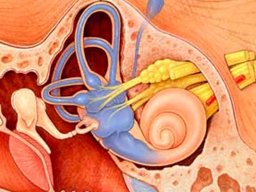
Meniere's disease (MD) is a disorder of the inner ear that is characterized by episodes of feeling like the world is spinning (vertigo), ringing in the ears (tinnitus), hearing loss, and a fullness in the ear. Typically only one ear is affected, at least initially; however, over time both ears may become involved. Episodes generally last from 20 minutes to a few hours. The time between episodes varies. The hearing loss and ringing in the ears may become constant over time.

A migraine is a primary headache disorder characterized by recurrent headaches that are moderate to severe. Typically, the headaches affect one half of the head, are pulsating in nature, and last from two to 72 hours. Associated symptoms may include nausea, vomiting, and sensitivity to light, sound, or smell. The pain is generally made worse by physical activity. Up to one-third of people have an aura: typically a short period of visual disturbance that signals that the headache will soon occur. Occasionally, an aura can occur with little or no headache following it.
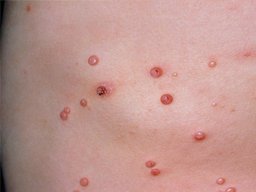
Molluscum contagiosum (MC), sometimes called water warts, is a viral infection of the skin that results in small, raised, pink lesions with a dimple in the center. They may occasionally be itchy or sore. They may occur singly or in groups. Any area of the skin may be affected, with abdomen, legs, arms, neck, genital area, and face being most common. Onset of the lesions is around 7 weeks after infection. It usually goes away within a year without scarring. MC is caused by a poxvirus called the molluscum contagiosum virus (MCV).

A mouth ulcer is an ulcer that occurs on the mucous membrane of the oral cavity. Mouth ulcers are very common, occurring in association with many diseases and by many different mechanisms, but usually there is no serious underlying cause. The two most common causes of oral ulceration are local trauma (e.g. rubbing from a sharp edge on a broken filling) and aphthous stomatitis ("canker sores"), a condition characterized by recurrent formation of oral ulcers for largely unknown reasons. Mouth ulcers often cause pain and discomfort, and may alter the person's choice of food while healing occurs (e.g. avoiding acidic or spicy foods and beverages). They may form individually or multiple ulcers may appear at the same time (a "crop" of ulcers).

Multiple sclerosis (MS) is a demyelinating disease in which the insulating covers of nerve cells in the brain and spinal cord are damaged. This damage disrupts the ability of parts of the nervous system to communicate, resulting in a range of signs and symptoms, including physical, mental, and sometimes psychiatric problems. Specific symptoms can include double vision, blindness in one eye, muscle weakness, trouble with sensation, or trouble with coordination. MS takes several forms, with new symptoms either occurring in isolated attacks (relapsing forms) or building up over time (progressive forms). Between attacks, symptoms may disappear completely; however, permanent neurological problems often remain, especially as the disease advances.

Myasthenia gravis (MG) is a long-term neuromuscular disease that leads to varying degrees of skeletal muscle weakness. The most commonly affected muscles are those of the eyes, face, and swallowing. It can result in double vision, drooping eyelids, trouble talking, and trouble walking. Onset can be sudden. Those affected often have a large thymus gland or develop a thymoma. Myasthenia gravis is an autoimmune disease which results from antibodies that block or destroy nicotinic acetylcholine receptors at the junction between the nerve and muscle.

Near-sightedness, also known as short-sightedness and myopia, is a condition of the eye where light focuses in front of, instead of on, the retina. This causes distant objects to be blurry while close objects appear normal. Other symptoms may include headaches and eye strain. Severe near-sightedness increases the risk of retinal detachment, cataracts, and glaucoma. The underlying cause is believed to be a combination of genetic and environmental factors. Risk factors include doing work that involves focusing on close objects, greater time spent indoors, and a family history of the condition.It is also associated with a high socioeconomic class.
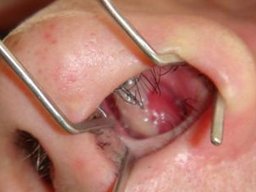
Nasal polyps (NP) are noncancerous growths within the nose or sinuses. Symptoms include trouble breathing through the nose, loss of smell, decreased taste, post nasal drip, and a runny nose. The growths are sac-like, movable, and nontender, though face pain may occasionally occur. They typically occur in both nostrils in those who are affected. Complications may include sinusitis and broadening of the nose. The exact cause is unclear. They may be related to chronic inflammation of the lining of the sinuses. They occur more commonly among people who have allergies, cystic fibrosis, aspirin sensitivity, or certain infections. The polyp itself represents an overgrowth of the mucous membranes. Diagnosis may occur by looking up the nose. A CT scan may be used to determine the number of polyps and help plan surgery.

Nephrotic syndrome is a collection of symptoms due to kidney damage. This includes protein in the urine, low blood albumin levels, high blood lipids, and significant swelling. Other symptoms may include weight gain, feeling tired, and foamy urine. Complications may include blood clots, infections, and high blood pressure. Causes include a number of kidney diseases such as focal segmental glomerulosclerosis, membranous nephropathy, and minimal change disease. It may also occur as a complication of diabetes or lupus. The underlying mechanism typically involves damage to the glomeruli of the kidney. Diagnosis is typically based on urine testing and sometimes a kidney biopsy.

Neuritis is inflammation of a nerve or the general inflammation of the peripheral nervous system. Symptoms depend on the nerves involved but may include pain, paresthesia (pins-and-needles), paresis (weakness), hypoesthesia (numbness), anesthesia, paralysis, wasting, and disappearance of the reflexes. Causes, Physical injury, Infection, Diphtheria, Herpes zoster (shingles), Leprosy, Lyme disease, Chemical injury such as chemotherapy Radiation therapy
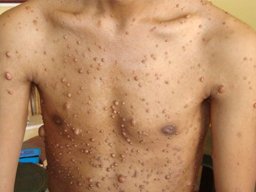
Neurofibromatosis (NF) is a group of three conditions in which tumors grow in the nervous system. The three types are neurofibromatosis type 1 (NF1), neurofibromatosis type 2 (NF2), and schwannomatosis. In NF1 symptoms include light brown spots on the skin, freckles in the armpit and groin, small bumps within nerves, and scoliosis. In NF2 there may be hearing loss, cataracts at a young age, balance problems, flesh colored skin flaps, and muscle wasting. The tumors are generally non-cancerous. The cause is a genetic mutation in certain genes. In half of cases these are inherited from a person's parents while in the rest, they occur during early development.

Obesity is a medical condition in which excess body fat has accumulated to the extent that it may have a negative effect on health. People are generally considered obese when their body mass index (BMI), a measurement obtained by dividing a person's weight by the square of the person's height, is over 30 kg/m2, with the range 25-30 kg/m2 defined as overweight. Some East Asian countries use lower values. Obesity increases the likelihood of various diseases and conditions, particularly cardiovascular diseases, type 2 diabetes, obstructive sleep apnea, certain types of cancer, osteoarthritis and depression.

Obsessive-compulsive disorder (OCD) is a mental disorder where people feel the need to check things repeatedly, perform certain routines repeatedly (called "rituals"), or have certain thoughts repeatedly (called "obsessions"). People are unable to control either the thoughts or the activities for more than a short period of time. Common activities include hand washing, counting of things, and checking to see if a door is locked. Some may have difficulty throwing things out. These activities occur to such a degree that the person's daily life is negatively affected. This often takes up more than an hour a day. Most adults realize that the behaviors do not make sense. The condition is associated with tics, anxiety disorder, and an increased risk of suicide.

Osteoarthritis (OA) is a type of joint disease that results from breakdown of joint cartilage and underlying bone. The most common symptoms are joint pain and stiffness. Initially, symptoms may occur only following exercise, but over time may become constant. Other symptoms may include joint swelling, decreased range of motion, and, when the back is affected, weakness or numbness of the arms and legs. The most commonly involved joints are those near the ends of the fingers, at the base of the thumb, neck, lower back, knee, and hips. Joints on one side of the body are often more affected than those on the other. Usually the symptoms come on over years. It can affect work and normal daily activities. Unlike other types of arthritis, only the joints are typically affected.
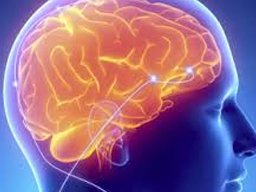
Parkinson's disease (PD) is a long-term degenerative disorder of the central nervous system that mainly affects the motor system. The symptoms generally come on slowly over time. Early in the disease, the most obvious are shaking, rigidity, slowness of movement, and difficulty with walking. Thinking and behavioral problems may also occur. Dementia becomes common in the advanced stages of the disease. Depression and anxiety are also common, occurring in more than a third of people with PD. Other symptoms include sensory, sleep, and emotional problems. The main motor symptoms are collectively called "parkinsonism", or a "parkinsonian syndrome".

Polycystic ovary syndrome (PCOS) is a set of symptoms due to elevated androgens (male hormones) in females. Signs and symptoms of PCOS include irregular or no menstrual periods, heavy periods, excess body and facial hair, acne, pelvic pain, difficulty getting pregnant, and patches of thick, darker, velvety skin. Associated conditions include type 2 diabetes, obesity, obstructive sleep apnea, heart disease, mood disorders, and endometrial cancer.

Peptic ulcer disease (PUD) is a break in the lining of the stomach, first part of the small intestine or occasionally the lower esophagus. An ulcer in the stomach is known as a gastric ulcer while that in the first part of the intestines is known as a duodenal ulcer. The most common symptoms of a duodenal ulcer are waking at night with upper abdominal pain or upper abdominal pain that improves with eating. With a gastric ulcer the pain may worsen with eating. The pain is often described as a burning or dull ache. Other symptoms include belching, vomiting, weight loss, or poor appetite. About a third of older people have no symptoms. Complications may include bleeding, perforation and blockage of the stomach. Bleeding occurs in as many as 15% of people.
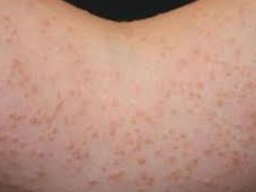
Photodermatitis, sometimes referred to as sun poisoning or photoallergy, is a form of allergic contact dermatitis in which the allergen must be activated by light to sensitize the allergic response, and to cause a rash or other systemic effects on subsequent exposure. The second and subsequent exposures produce photoallergic skin conditions which are often eczematous. It is distinct from sunburn. Photodermatitis may result in swelling, difficulty breathing, a burning sensation, a red itchy rash sometimes resembling small blisters, and peeling of the skin. Nausea may also occur. There may also be blotches where the itching may persist for long periods of time. In these areas an unsightly orange to brown tint may form, usually near or on the face.

Hemorrhoids, also called piles, are vascular structures in the anal canal. In their normal state, they are cushions that help with stool control. They become a disease when swollen or inflamed; the unqualified term "hemorrhoid" is often used to refer to the disease. The signs and symptoms of hemorrhoids depend on the type present. Internal hemorrhoids often result in painless, bright red rectal bleeding when defecating. External hemorrhoids often result in pain and swelling in the area of the anus. If bleeding occurs it is usually darker. Symptoms frequently get better after a few days. A skin tag may remain after the healing of an external hemorrhoid.

Prostate cancer is the development of cancer in the prostate, a gland in the male reproductive system. Most prostate cancers are slow growing; however, some grow relatively quickly. The cancer cells may spread from the prostate to other area of the body, particularly the bones and lymph nodes. It may initially cause no symptoms. In later stages, it can lead to difficulty urinating, blood in the urine or pain in the pelvis, back, or when urinating. A disease known as benign prostatic hyperplasia may produce similar symptoms. Other late symptoms may include feeling tired due to low levels of red blood cells. Factors that increase the risk of prostate cancer include older age, a family history of the disease, and race.
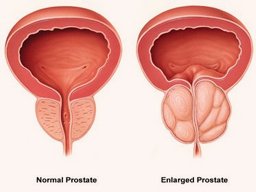
Prostatitis is swelling and inflammation of the prostate gland, a walnut-sized gland situated directly below the bladder in men. The prostate gland produces fluid (semen) that nourishes and transports sperm. Prostatitis often causes painful or difficult urination. Other symptoms include pain in the groin, pelvic area or genitals and sometimes flu-like symptoms. Prostatitis affects men of all ages but tends to be more common in men 50 or younger. The condition has a number of causes. Sometimes the cause isn't identified. If prostatitis is caused by a bacterial infection, it can usually be treated with antibiotics.

Tuberculosis (TB) is an infectious disease usually caused by the bacterium Mycobacterium tuberculosis (MTB). Tuberculosis generally affects the lungs, but can also affect other parts of the body. Most infections do not have symptoms, in which case it is known as latent tuberculosis. About 10% of latent infections progress to active disease which, if left untreated, kills about half of those infected. The classic symptoms of active TB are a chronic cough with blood-containing sputum, fever, night sweats, and weight loss. The historical term "consumption" came about due to the weight loss. Infection of other organs can cause a wide range of symptoms.
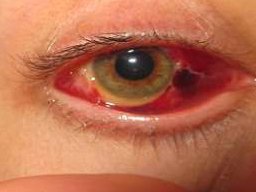
Retinal detachment is a disorder of the eye in which the retina separates from the layer underneath. Symptoms include an increase in the number of floaters, flashes of light, and worsening of the outer part of the visual field. This may be described as a curtain over part of the field of vision. In about 7% of cases both eyes are affected. Without treatment permanent loss of vision may occur. The mechanism most commonly involves a break in the retina that then allows the fluid in the eye to get behind the retina. A break in the retina can occur from a posterior vitreous detachment, injury to the eye, or inflammation of the eye. Other risk factors include being short sighted and previous cataract surgery. Retinal detachments also rarely occur due to a choroidal tumor. Diagnosis is by either looking at the back of the eye with an ophthalmoscope or by ultrasound.

Rheumatoid arthritis (RA) is a long-term autoimmune disorder that primarily affects joints. It typically results in warm, swollen, and painful joints.Pain and stiffness often worsen following rest. Most commonly, the wrist and hands are involved, with the same joints typically involved on both sides of the body. The disease may also affect other parts of the body. This may result in a low red blood cell count, inflammation around the lungs, and inflammation around the heart. Fever and low energy may also be present. Often, symptoms come on gradually over weeks to months. While the cause of rheumatoid arthritis is not clear, it is believed to involve a combination of genetic and environmental factors.

Schizophrenia is a mental disorder characterized by abnormal social behavior and failure to understand reality. Common symptoms include false beliefs, unclear or confused thinking, hearing voices that others do not, reduced social engagement and emotional expression, and a lack of motivation. People with schizophrenia often have additional mental health problems such as anxiety, depressive, or substance-use disorders. Symptoms typically come on gradually, begin in young adulthood, and last a long time. The causes of schizophrenia include environmental and genetic factors.

Sciatica is a medical condition characterized by pain going down the leg from the lower back. This pain may go down the back, outside, or front of the leg. Onset is often sudden following activities like heavy lifting, though gradual onset may also occur. Typically, symptoms are only on one side of the body. Certain causes, however, may result in pain on both sides. Lower back pain is sometimes but not always present. Weakness or numbness may occur in various parts of the affected leg and foot.

Seborrhoeic dermatitis, also known as seborrhoea, is a long-term skin disorder. Symptoms include red, scaly, greasy, itchy, and inflamed skin. Areas of the skin rich in oil-producing glands are often affected including the scalp, face, and chest. It can result in social or self-esteem problems. In babies, when the scalp is primarily involved, it is called cradle cap. Dandruff is a milder form of the condition, without associated inflammation. The cause is unclear but believed to involve a number of genetic and environmental factors. Risk factors include poor immune function, Parkinson disease, epilepsy, and Down syndrome. The condition may worsen with stress or during the winter. It is not a result of poor hygiene. Diagnosis is typically based on the symptoms. The typical treatment is antifungal cream and anti-inflammatory agents.
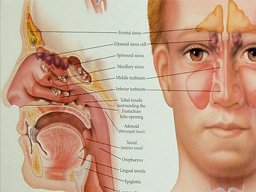
Sinusitis, also known as a sinus infection or rhinosinusitis, is inflammation of the sinuses resulting in symptoms. Common symptoms include thick nasal mucus, a plugged nose, and pain in the face. Other signs and symptoms may include fever, headaches, poor sense of smell, sore throat, and cough. The cough is often worse at night.Serious complications are rare. It is defined as acute rhinosinusitis (ARS) if it lasts less than 4 weeks, and as chronic rhinosinusitis (CRS) if it lasts for more than 12 weeks. Sinusitis can be caused by infection, allergies, air pollution, or structural problems in the nose.

Insomnia, also known as sleeplessness, is a sleep disorder where people have trouble sleeping. They may have difficulty falling asleep, or staying asleep as long as desired. Insomnia is typically followed by daytime sleepiness, low energy, irritability, and a depressed mood. It may result in an increased risk of motor vehicle collisions, as well as problems focusing and learning. Insomnia can be short term, lasting for days or weeks, or long term, lasting more than a month. Insomnia can occur independently or as a result of another problem. Conditions that can result in insomnia include psychological stress, chronic pain, heart failure, hyperthyroidism, heartburn, restless leg syndrome, menopause, certain medications, and drugs such as caffeine, nicotine, and alcohol.

Tennis elbow or lateral epicondylitis is a condition in which the outer part of the elbow becomes sore and tender at the lateral epicondyle. The forearm muscles and tendons become damaged from repetitive overuse. This leads to pain and tenderness on the outside of the elbow. Any activity, including playing tennis, that involves repetitive use of the extensor muscles of the forearm can cause acute or chronic tendonitis of the tendinous insertion of these muscles at the lateral epicondyle of the elbow. The condition is common in carpenters and laborers who swing a hammer or other tool with the forearm, and is similar to golfer's elbow, which affects the medial epicondyle on the inside of the elbow. Continuing activity after onset of the condition and avoiding mandatory rest may lead to permanent onset of pain and only treatable via surgery.
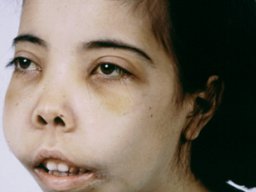
Thalassemias are inherited blood disorders characterized by abnormal hemoglobin production. Symptoms depend on the type and can vary from none to severe. Often there is mild to severe anemia (low red blood cells). Anemia can result in feeling tired and pale skin. There may also be bone problems, an enlarged spleen, yellowish skin, dark urine, and among children slow growth. Thalassemias are genetic disorders inherited from a person's parents. There are two main types, alpha thalassemia and beta thalassemia. The severity of alpha and beta thalassemia depends on how many of the four genes for alpha globin or two genes for beta globin are missing.

Beta thalassemias ( thalassemias) are a group of inherited blood disorders. They are forms of thalassemia caused by reduced or absent synthesis of the beta chains of hemoglobin that result in variable outcomes ranging from severe anemia to clinically asymptomatic individuals. Global annual incidence is estimated at one in 100,000. Beta thalassemias are caused by mutations in the HBB gene on chromosome 11, inherited in an autosomal recessive fashion. The severity of the disease depends on the nature of the mutation. HBB blockage over time leads to decreased beta-chain synthesis.

Tinnitus is the hearing of sound when no external sound is present. While often described as a ringing, it may also sound like a clicking, hiss or roaring. Rarely, unclear voices or music are heard. The sound may be soft or loud, low pitched or high pitched and appear to be coming from one ear or both. Most of the time, it comes on gradually. In some people, the sound causes depression or anxiety and can interfere with concentration. Tinnitus is not a disease but a symptom that can result from a number of underlying causes.

Tonsillitis is inflammation of the tonsils, typically of rapid onset. It is a type of pharyngitis. Symptoms may include sore throat, fever, enlargement of the tonsils, trouble swallowing, and large lymph nodes around the neck. Complications include peritonsillar abscess. Tonsillitis is most commonly caused by a viral infection, with about 5% to 40% of cases caused by a bacterial infection.[4][5] When caused by the bacterium group A streptococcus, it is referred to as strep throat. Rarely bacteria such as Neisseria gonorrhoeae, Corynebacterium diphtheriae, or Haemophilus influenzae may be the cause. Typically the infection is spread between people through the air.
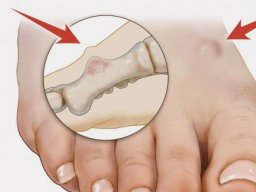
A bone tumor (also spelled bone tumour) is a neoplastic growth of tissue in bone. Abnormal growths found in the bone can be either benign (noncancerous) or malignant (cancerous). Average five-year survival in the United States after being diagnosed with bone and joint cancer is 67%. Bone tumors may be classified as "primary tumors", which originate in bone or from bone-derived cells and tissues, and "secondary tumors" which originate in other sites and spread (metastasize) to the skeleton. Carcinomas of the prostate, breasts, lungs, thyroid, and kidneys are the carcinomas that most commonly metastasize to bone. Secondary malignant bone tumors are estimated to be 50 to 100 times as common as primary bone cancers.

Typhoid fever, also known simply as typhoid, is a bacterial infection due to Salmonella typhi that causes symptoms. Symptoms may vary from mild to severe and usually begin six to thirty days after exposure. Often there is a gradual onset of a high fever over several days. Weakness, abdominal pain, constipation, and headaches also commonly occur. Diarrhea is uncommon and vomiting is not usually severe. Some people develop a skin rash with rose colored spots. In severe cases there may be confusion. Without treatment, symptoms may last weeks or months. Other people may carry the bacterium without being affected; however, they are still able to spread the disease to others.

Ulcerative colitis (UC) is a long-term condition that results in inflammation and ulcers of the colon and rectum. The primary symptom of active disease is abdominal pain and diarrhea mixed with blood. Weight loss, fever, and anemia may also occur. Often symptoms come on slowly and can range from mild to severe. Symptoms typically occur intermittently with periods of no symptoms between flares. Complications may include megacolon, inflammation of the eye, joints, or liver, and colon cancer. The cause of UC is unknown. Theories involve immune system dysfunction, genetics, changes in the normal gut bacteria, and environmental factors.
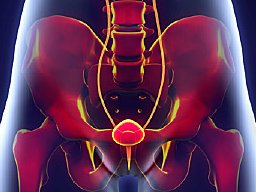
A urinary tract infection (UTI) is an infection that affects part of the urinary tract. When it affects the lower urinary tract it is known as a bladder infection (cystitis) and when it affects the upper urinary tract it is known as kidney infection (pyelonephritis). Symptoms from a lower urinary tract include pain with urination, frequent urination, and feeling the need to urinate despite having an empty bladder. Symptoms of a kidney infection include fever and flank pain usually in addition to the symptoms of a lower UTI. Rarely the urine may appear bloody.In the very old and the very young, symptoms may be vague or non-specific. The most common cause of infection is Escherichia coli, though other bacteria or fungi may rarely be the cause

Urticaria, is a kind of skin rash with red, raised, itchy bumps. They may also burn or sting. Often the patches of rash move around. Typically they last a few days and do not leave any long-lasting skin changes. Fewer than 5% of cases last for more than six weeks. The condition frequently recurs. Hives frequently occur following an infection or as a result of an allergic reaction such as to medication, insect bites, or food. Psychological stress, cold temperature, or vibration may also be a trigger. In half of cases the cause remains unknown. Risk factors include having conditions such as hay fever or asthma. Diagnosis is typically based on the appearance. Patch testing may be useful to determine the allergy.
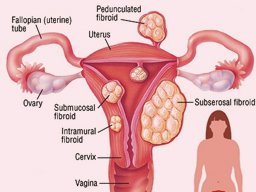
Uterine fibroids, also known as uterine leiomyomas or fibroids, are benign smooth muscle tumors of the uterus. Most women have no symptoms while others may have painful or heavy periods. If large enough, they may push on the bladder causing a frequent need to urinate. They may also cause pain during sex or lower back pain. A woman can have one uterine fibroid or many. Occasionally, fibroids may make it difficult to become pregnant, although this is uncommon. The exact cause of uterine fibroids is unclear. However, fibroids run in families and appear to be partly determined by hormone levels. Risk factors include obesity and eating red meat. Diagnosis can be performed by pelvic examination or medical imaging.

Varicose veins are veins that have become enlarged and twisted. The term commonly refers to the veins on the leg, although varicose veins can occur elsewhere. Veins have pairs of leaflet valves to prevent blood from flowing backwards (retrograde flow or venous reflux). Leg muscles pump the veins to return blood to the heart (the skeletal-muscle pump), against the effects of gravity. When veins become varicose, the leaflets of the valves no longer meet properly, and the valves do not work (valvular incompetence). This allows blood to flow backwards and they enlarge even more. Varicose veins are most common in the superficial veins of the legs, which are subject to high pressure when standing. Besides being a cosmetic problem, varicose veins can be painful, especially when standing.

Vertigo is a symptom where a person feels as if they or the objects around them are moving when they are not. Often it feels like a spinning or swaying movement. This may be associated with nausea, vomiting, sweating, or difficulties walking. It is typically worse when the head is moved. Vertigo is the most common type of dizziness. The most common diseases that result in vertigo are benign paroxysmal positional vertigo (BPPV), Meiere's disease, and labyrinthitis. Less common causes include stroke, brain tumors, brain injury, multiple sclerosis, migraines, trauma, and uneven pressures between the middle ears. Physiologic vertigo may occur following being exposed to motion for a prolonged period such as when on a ship or simply following spinning with the eyes closed.

Vitiligo is a long-term skin condition characterized by patches of the skin losing their pigment. The patches of skin affected become white and usually have sharp margins. The hair from the skin may also become white. The inside of the mouth and nose may also be involved. Typically both sides of the body are affected. Often the patches begin on areas of skin that are exposed to the sun. It is more noticeable in people with dark skin. Vitiligo may result in psychological stress and those affected may be stigmatized.
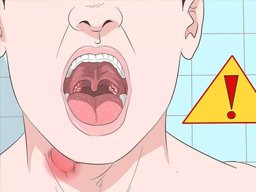
Vocal fold nodules are growths that form on the vocal folds. They are benign, or not cancerous. When you use your voice the wrong way, your vocal folds may swell. Over time, the swollen spots can get harder, like a callous. These nodules can get larger and stiffer if your vocal abuse continues. Polyps can be on one or both of the vocal folds. They may look like a swollen spot or bump, a blister, or a thin, long growth. Most polyps are bigger than nodules. You may hear them called polypoid degeneration or Reinke's edema. It may be easiest to think of a nodule as a callous and a polyp as a blister.
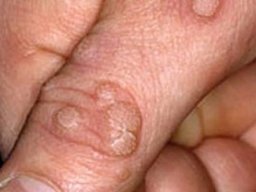
Warts are typically small, rough, and hard growths that are similar in color to the rest of the skin. They typically do not result in symptoms except when on the bottom of the feet where they may be painful. While they usually occur on the hands and feet they can also affect other locations. One or many warts may appear. They are not cancerous. Warts are caused by infection with a type of human papillomavirus (HPV).Factors that increase the risk include use of public showers, working with meat, eczema, and a low immune system.